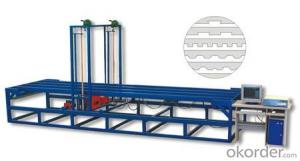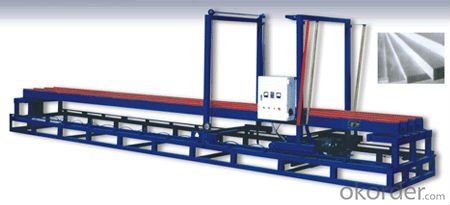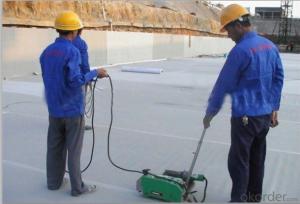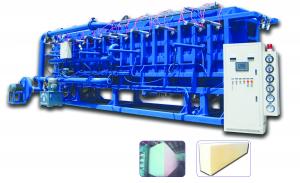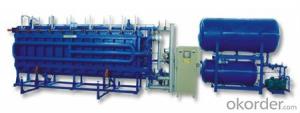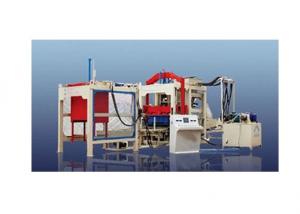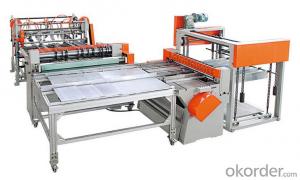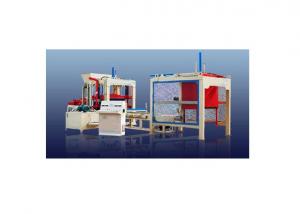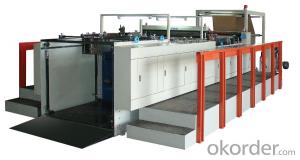Automatic block cutting machine and riding mould cutting machine
- Loading Port:
- Tianjin
- Payment Terms:
- TT OR LC
- Min Order Qty:
- 1 set
- Supply Capability:
- 80 set/month
OKorder Service Pledge
OKorder Financial Service
You Might Also Like
EPS block cutting machine
Main Features:
1. The main frame of the machine is welded from square profile steel, with strong structure, high strength and no deformation.
2. The machine has horizontal, vertical and cross cutting devices, and can realize 3-direction cutting. i.e. horizontal, vertical and cross cutting.
3. The machine adopts converter speed governing advantageous in stable moving, large range (0-4m/min) of step-less speed governing, suitable for requirements of low-speed cutting and fast cutter-retract.
Technical Data:
Item | PSC2000 | PSC4000 | PSC6000 | PSC8000 |
Max block size | 2000*1300*1300(mm) | 4000*1300*1300(mm) | 6000*1300*1300(mm) | 8000*1300*1300(mm) |
Connected load | 11.2KW | 11.2kw | 11.2kw | 11.2kw |
Overall dimension | 4800*1950*1850(mm) | 6800*1950*2450(mm) | 8800*1950*2450(mm) | 10800*1950*2450(mm) |
Overall weight | 800kg | 1200kg | 1600kg | 2000kg |
- Q: Can a waterproofing membrane be used in conjunction with fire protection systems?
- Yes, a waterproofing membrane can be used in conjunction with fire protection systems. While the primary function of a waterproofing membrane is to prevent water penetration, it can also act as a barrier to protect against fire. Some waterproofing membranes have fire-resistant properties, allowing them to withstand high temperatures and prevent the spread of fire. However, it is essential to ensure that the specific waterproofing membrane chosen is compatible and approved for use with the fire protection system in question.
- Q: Can a waterproofing membrane be applied on a vertical surface?
- Yes, a waterproofing membrane can be applied on a vertical surface. Waterproofing membranes are designed to create a barrier against water penetration, whether it is applied horizontally or vertically. They are commonly used on vertical surfaces such as walls, retaining walls, and foundations to prevent water damage and leakage.
- Q: Can a waterproofing membrane be used in boat decks or marinas?
- Yes, a waterproofing membrane can be used in boat decks or marinas. It is commonly used to protect the underlying structure from water damage and provide a durable, watertight barrier that helps prevent leaks and deterioration.
- Q: Is a waterproofing membrane resistant to freeze-thaw cycles?
- Yes, a waterproofing membrane is resistant to freeze-thaw cycles. This is because the membrane is designed to prevent the penetration of water, which can expand and contract during freeze-thaw cycles. The membrane acts as a barrier, preventing water from seeping into the structure and causing damage due to freezing and thawing. Additionally, waterproofing membranes are typically made from materials that are flexible and able to withstand temperature fluctuations without losing their effectiveness.
- Q: Can a waterproofing membrane be applied to existing structures?
- Yes, a waterproofing membrane can be applied to existing structures. The application of a waterproofing membrane is a common and effective method used to prevent water infiltration and damage to buildings. Whether it is a concrete structure, a roof, or a basement, waterproofing membranes can be installed on the exterior or interior surfaces to create a barrier against water penetration. There are different types of waterproofing membranes available, such as liquid-applied membranes, sheet membranes, and spray-applied membranes, which can be chosen based on the specific requirements of the structure. The process of applying a waterproofing membrane to an existing structure typically involves thorough surface preparation, including cleaning, repairing any existing cracks or damages, and ensuring a smooth and even surface. Once the surface is prepared, the membrane is applied using the recommended method, ensuring proper adhesion and coverage. Waterproofing membranes are designed to withstand environmental factors, such as UV rays, temperature fluctuations, and water pressure, providing long-lasting protection to existing structures. However, it is important to consult with a professional waterproofing contractor to assess the condition of the structure and determine the most appropriate and effective waterproofing solution.
- Q: Can a waterproofing membrane be used for interior applications?
- Yes, a waterproofing membrane can be used for interior applications. It is commonly used in bathrooms, kitchens, basements, and other areas where moisture or water damage is a concern. The membrane helps prevent water penetration and protects the underlying structure from potential damage.
- Q: How does a waterproofing membrane handle joint movement?
- A waterproofing membrane is designed to accommodate joint movement by being flexible and elastic. It can stretch and contract along with the joints, ensuring that there are no gaps or cracks through which water can penetrate. This flexibility allows the membrane to maintain its integrity and effectiveness even when the structure experiences movement due to factors like temperature changes or settling.
- Q: Can waterproofing membranes be used on concrete planters?
- Concrete planters can indeed benefit from the use of waterproofing membranes. These membranes are specifically designed to create a strong barrier against water, effectively preventing any water from penetrating the concrete and causing harm. By applying a waterproofing membrane to a concrete planter, it guarantees that the planter will remain completely watertight, thus avoiding any potential leaks or damage to the surrounding area. This is particularly advantageous for planters located indoors or in areas where water leakage could lead to structural harm or messy situations. Moreover, waterproofing membranes also provide an additional advantage by safeguarding the concrete against freeze-thaw cycles, which can ultimately result in cracks and deterioration over time. Overall, the utilization of waterproofing membranes on concrete planters enables an extended lifespan and the preservation of their functionality for an extended duration.
- Q: Can a waterproofing membrane be used on swimming pool decks?
- Yes, a waterproofing membrane can be used on swimming pool decks. It helps to prevent water damage and leakage, ensuring durability and longevity of the deck.
- Q: Can a waterproofing membrane be used for a foundation?
- Yes, a waterproofing membrane can be used for a foundation. Waterproofing membranes are designed to provide a barrier against water infiltration and can be used to protect the foundation from moisture damage. These membranes are typically made from materials such as bitumen, rubberized asphalt, or polymer-based sheets that are installed on the exterior side of the foundation walls. They are designed to prevent water from seeping into the foundation, which can help to prevent potential issues such as water damage, mold growth, and structural deterioration. It is important to ensure that the waterproofing membrane is properly installed and meets the specific requirements of the foundation to ensure its effectiveness.
Send your message to us
Automatic block cutting machine and riding mould cutting machine
- Loading Port:
- Tianjin
- Payment Terms:
- TT OR LC
- Min Order Qty:
- 1 set
- Supply Capability:
- 80 set/month
OKorder Service Pledge
OKorder Financial Service
Similar products
Hot products
Hot Searches
Related keywords
